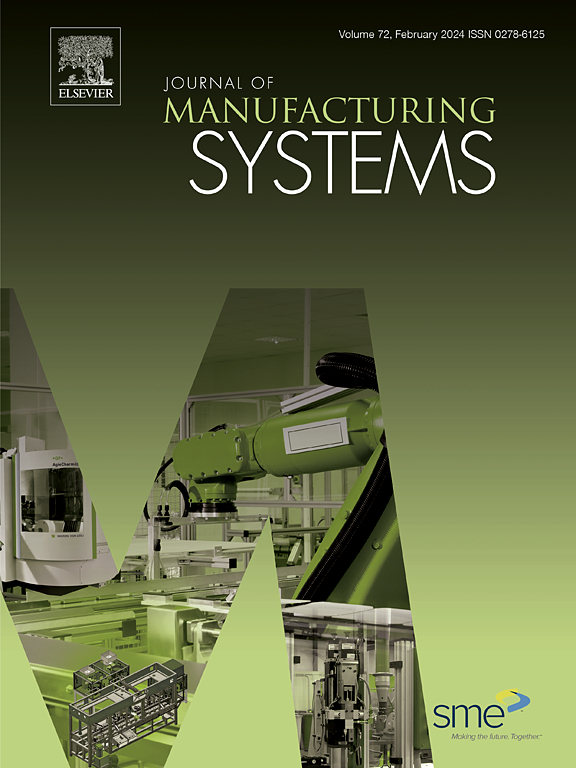Digital twin of dynamics for parallel kinematic machine with distributed force/position interaction
IF 12.2
1区 工程技术
Q1 ENGINEERING, INDUSTRIAL
引用次数: 0
Abstract
Extensibility is significant for digital twin (DT) manufacturing systems. However, existing DT models mainly focus on a specific task in manufacturing. The main challenge lies in the specific physical model when addressing different tasks. In fact, the dynamics of machines are the physical basis for most applications, e.g., motion planning, production scheduling, process monitoring, machine maintenance, and so on. Therefore, the Digital Twin of dynamics (DTOD) for machines will be a foundation for a highly integrated and extensible DT system. However, due to the challenges in real-time dynamic modeling and the corresponding data interaction methods, the DTOD for parallel kinematic machines (PKM) has not been realized.
Facing this challenge, this paper develops a DTOD for PKM with distributed force/position interaction. Firstly, a simplified rigid-flexible coupling dynamic model of PKM, considering link deformations, is established for real-time calculation. Then, a distributed position/force interaction method based on Kalman filter-based data fusion is proposed to realize high-performance data interaction between cyber and physical space. On this basis, a five-dimension digital twin model for DTOD of PKM is established. Further, the DTOD system with an architecture comprising dual central processors and multiple distributed edge executors/sensors is developed and validated by aircraft gear manufacturing, showing 80 % prediction accuracy of dynamic error. Finally, to show the extensibility, integrated error correction for aircraft gear manufacturing is proposed as an extended application of the DTOD system. The gear error is reduced to 218 μm (with error correction) from 503 μm, representing a reduction of about 57 %, showing the high performance of the developed DTOD system and its high application potential.
具有分布力/位相互作用的并联机械动力学数字孪生
对于数字孪生(DT)制造系统来说,可扩展性是非常重要的。然而,现有的DT模型主要关注制造中的特定任务。主要的挑战在于处理不同任务时的具体物理模型。事实上,机器的动力学是大多数应用程序的物理基础,例如,运动计划、生产调度、过程监控、机器维护等等。因此,机器的动态数字孪生(DTOD)将成为高度集成和可扩展的动态数字孪生系统的基础。然而,由于实时动态建模和相应的数据交互方法的挑战,并联机构的DTOD尚未实现。针对这一挑战,本文提出了一种力/位分布相互作用的PKM DTOD方法。首先,建立了考虑连杆变形的PKM刚柔耦合简化动力学模型,并进行了实时计算。在此基础上,提出了一种基于卡尔曼滤波的分布式位置/力交互方法,实现了网络空间与物理空间的高性能数据交互。在此基础上,建立了PKM DTOD的五维数字孪生模型。此外,开发了由双中央处理器和多个分布式边缘执行器/传感器组成的DTOD系统,并通过飞机齿轮制造进行了验证,动态误差预测精度为80% %。最后,为了展示该系统的可扩展性,提出了将DTOD系统作为扩展应用的飞机齿轮制造集成误差校正。齿轮误差从503 μm减小到218 μm(含误差校正),减小幅度约为57. %,显示了所开发的DTOD系统的高性能和巨大的应用潜力。
本文章由计算机程序翻译,如有差异,请以英文原文为准。
求助全文
约1分钟内获得全文
求助全文
来源期刊

Journal of Manufacturing Systems
工程技术-工程:工业
CiteScore
23.30
自引率
13.20%
发文量
216
审稿时长
25 days
期刊介绍:
The Journal of Manufacturing Systems is dedicated to showcasing cutting-edge fundamental and applied research in manufacturing at the systems level. Encompassing products, equipment, people, information, control, and support functions, manufacturing systems play a pivotal role in the economical and competitive development, production, delivery, and total lifecycle of products, meeting market and societal needs.
With a commitment to publishing archival scholarly literature, the journal strives to advance the state of the art in manufacturing systems and foster innovation in crafting efficient, robust, and sustainable manufacturing systems. The focus extends from equipment-level considerations to the broader scope of the extended enterprise. The Journal welcomes research addressing challenges across various scales, including nano, micro, and macro-scale manufacturing, and spanning diverse sectors such as aerospace, automotive, energy, and medical device manufacturing.
 求助内容:
求助内容: 应助结果提醒方式:
应助结果提醒方式:


